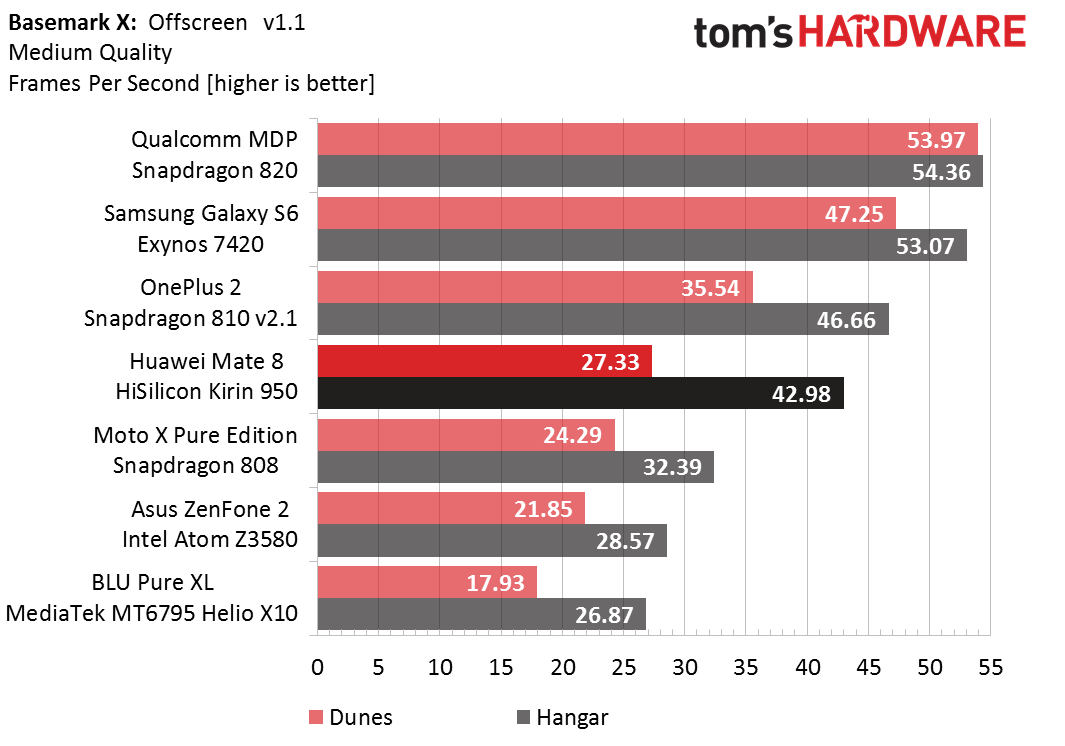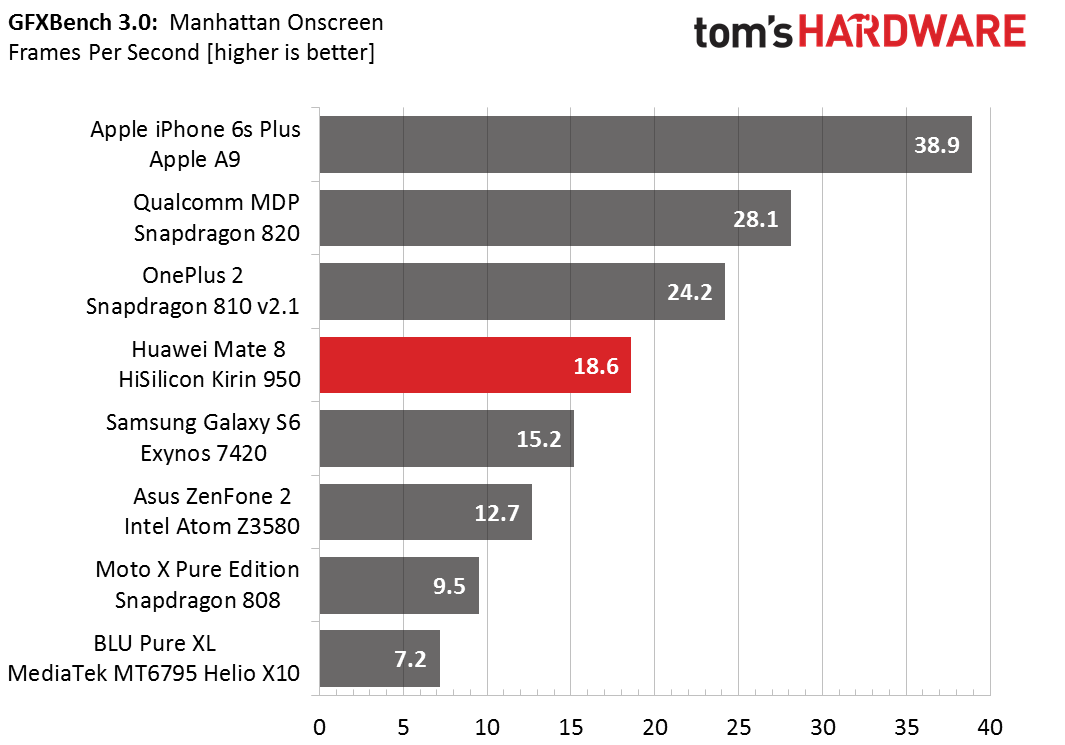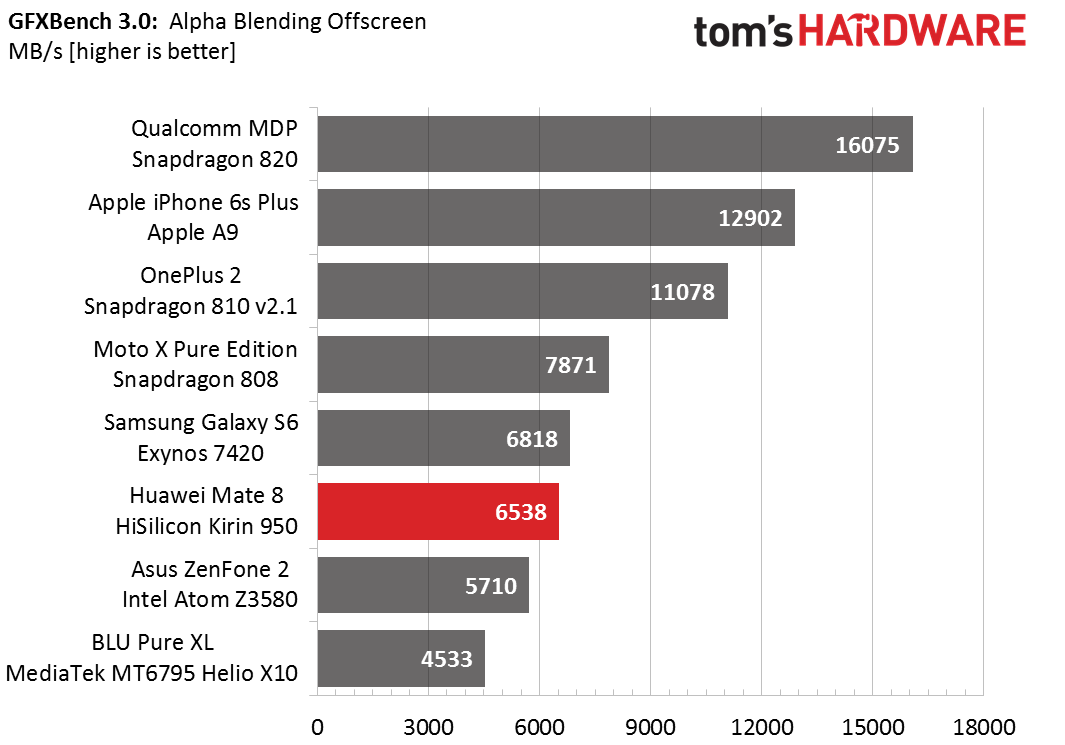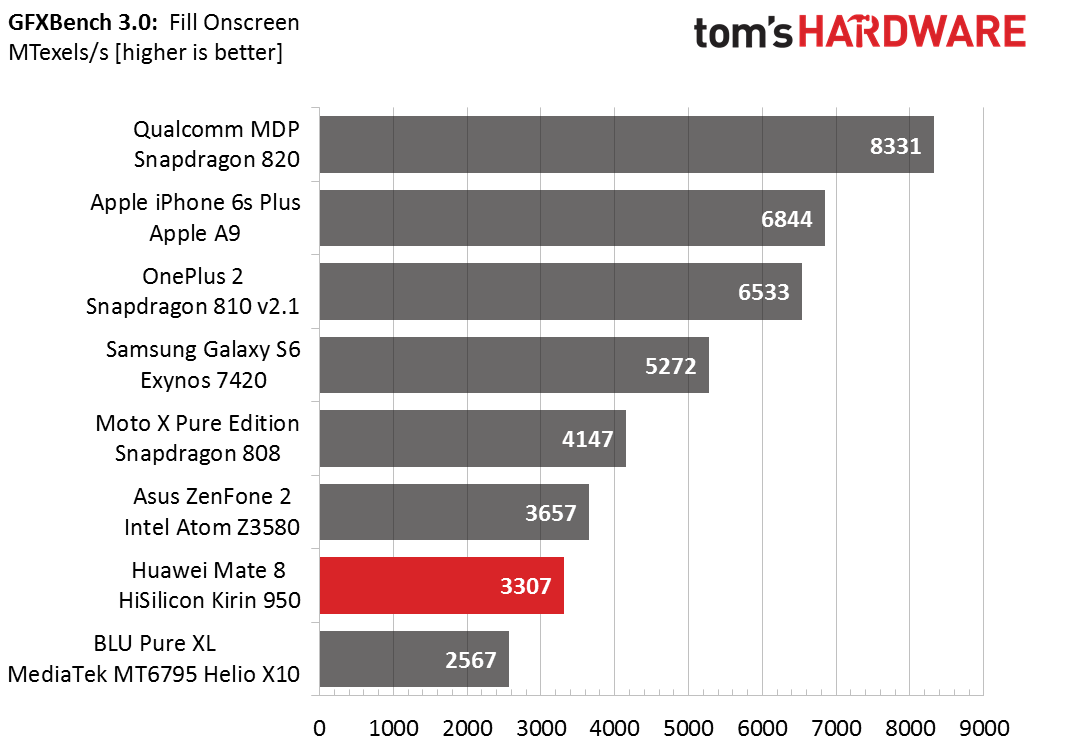Huawei Mate 8, Kirin 950, Cortex-A72 Benchmarks
We test Huawei's Mate 8 smartphone to see how its Kirin 950 SoC performs. This is also our first look at ARM's Cortex-A72 CPU core and new Mali-T880 GPU. How does A72 compare to the A57 and Snapdragon 820's Kryo cores?
GPU And Gaming Performance
This section explores GPU performance with several synthetic and real-world game engine tests. To learn more about how these benchmarks work, what versions we use, or our testing methodology, please read our article about how we test mobile device GPU performance.
HiSilicon's Kirin 950 uses an ARM Mali-T880MP4 GPU. While the architectural differences between the T880 and the model it replaces, the T760, are not completely known, we do know that the T880 includes three ALU units per core versus two ALUs per core for the T760.
| SoC | Kirin 950 | Exynos 7420 | Apple A8 | Apple A9 |
|---|---|---|---|---|
| GPU | ARM Mali-T880MP4 | ARM Mali-T760MP8 | PowerVR GX6450 | PowerVR GT7600 |
| Number of "cores" | 4 | 8 | 4 | 6 |
| FP32 ALUs per "core" | 2 | 3 | 32 | 32 |
| FP16 ALUs per "core" | ✗ | ✗ | 64 | 64 |
| Total FP32 FLOPS/cycle | 120 | 160 | 256 | 384 |
| Total FP16 FLOPS/cycle | 216 | 288 | 512 | 768 |
| Pixels/cycle | 4 | 8 | 8 | 12 |
| Texels/cycle | 4 | 8 | 8 | 12 |
The table above summarizes the relevant current and previous generation GPUs from ARM and Imagination Technologies. Differences in architecture and nomenclature make it difficult to directly compare GPU hardware, so it focuses more on end performance. Qualcomm's Adreno GPUs are not included, because the company does not disclose details about its architecture.
Mali's Midgard differs from other GPU architectures in several ways. For starters, Midgard's vector SIMDs (single instruction multiple data) rely exclusively on instruction level parallelism (ILP) to keep its ALUs full of instructions. Competing GPU architectures are not vector based, and use a combination of ILP and thread level parallelism (TLP). There's pros and cons for both methods, making it difficult to say which offers better performance, but it ultimately depends on the workload.
The table highlights another difference between the Mali Midgard, PowerVR Rogue, and Qualcomm's Adreno architectures: IPC. Midgard performs fewer operations per cycle than its peers, but ramps up to a higher max frequency. The Kirin 950 in the Mate 8, for example, runs at up to 900MHz, resulting in 108 GFLOPS of FP32 throughput. This trails the A8's 115 GFLOPS (6 percent), Exynos 7420's 124 GFLOPS (15 percent), and the A9's more than 173 GFLOPS (exact GPU frequency unknown).
Here we see the Mate 8's Kirin 950 performing very much like a mid-range device rather than a flagship, its quad-core GPU besting only the PowerVR G6200 in the MediaTek Helio X10. The Mate 8 actually does pretty well in the first graphics test that focuses on vertex operations (with minimal pixel processing), essentially tying with the Galaxy S6 and performing 12 percent better than the Moto X Pure Edition's Adreno 418 GPU. It's in the second graphics test, which focuses heavily on pixel operations, where it falls behind.
The Mate 8's Physics score is surprisingly low. Since this tests CPU and memory performance, the Mate 8 should score the same as or a little better than the Galaxy S6. Instead, the S6, with its A57 CPU cores, scores 31 percent better than the Mate 8's higher clocked A72 cores. Unfortunately, we had to return our review unit before we could investigate this further. Without a closer look (and a device running final software), we do not want to make too much of this result, but it warrants further investigation.
Get Tom's Hardware's best news and in-depth reviews, straight to your inbox.



In Basemark X, which runs on the Unity 4.2.2 game engine and uses OpenGL ES 2.0, the Galaxy S6 is 39 percent faster overall than the Mate 8. Most of its advantage comes from Dunes, a test that uses a lot of triangles (more than any of our other benchmarks), where it's 73 percent faster. HiSilicon's decision to use a quad-core GPU is definitely holding it back in this test; however, like all benchmarks, Basemark X puts more sever load on the GPU than actual games. When testing the LG G4 and its Snapdragon 808 SoC, for example, we found it played a number of modern games just fine. Considering that the Mate 8 actually performs better than the LG G4 in both offscreen and onscreen tests, and typical games do not use anywhere near as many triangles as Basemark X, the Mate 8's lower triangle performance should not be a severe limitation.
The Mate 8's 1080p display also works in its favor. By avoiding the greater rendering overhead of QHD, its onscreen Hangar results are actually better than the Galaxy S6's.



The Mali-T880MP4 GPU in the Kirin 950 really starts to struggle in the high quality test. With twice as many cores (giving it twice as much triangle and texturing throughput), the Mali-T760MP8 in the Exynos 7420 extends its lead to 70 percent overall (65 percent Dunes and 75 percent Hangar) when running offscreen.




GFXBench Manhattan runs on an OpenGL ES 3.0 based game engine that uses deferred rendering for its lighting effects. The PowerVR GT7600 in Apple's A9 and Adreno 530 in Qualcomm's Snapdragon 820 flex their ALU muscles, powering through the test's pixel operations. The Exynos 7420 in the Galaxy S6 also outperforms the Mate 8 by 35 percent. The Kirin 950 continues to outshine the Snapdragon 808 devices, though.
In the onscreen test, the Mate 8 pulls ahead of the Galaxy S6, since it only needs to render about half as many pixels.


Despite using an older OpenGL ES 2.0 based engine, we see essentially the same results in T-Rex. The Galaxy S6 is only 27 percent faster in the offscreen test than the Mate 8, and the Kirin 950 still holds a slim lead over the Snapdragon 808.









The limited number of ROPs in its quad-core GPU really holds the Kirin 950 and Mate 8 back in the Alpha Blending test, allowing the Snapdragon 808 to jump ahead of it. There's something amiss with the Galaxy S6's Alpha Blending results: The offscreen values are lower than the onscreen values, which is the opposite of what we should see. This appears to be a driver issue specific to the Galaxy S6, so we'll just ignore its results in this test.
The table at the top of this page documents the comparatively low FP32 ALU throughput of the Mali-T880MP4 GPU in Kirin 950, so it's no surprise to see it land near the bottom of the ALU performance chart. The Galaxy S6 scores 30 percent better than the Mate 8. Even the more budget friendly ZenFone 2 boasts better performance here. Qualcomm has worked steadily over the past several generations to boost the ALU performance of its Adreno GPUs, which is evident in this test. In the ALU onscreen test, nearly all of the devices are capped at the 60fps vsync limit.
While the T880 benefits from one additional ALU per core versus the T760, the Mali Midgard architecture makes no similar provision for texture units; the T880 still only has one per core. With twice as many texture units, the Galaxy S6 is 59 percent faster than the Mate 8 in the Fill test.
The Driver Overhead test measures CPU performance and driver efficiency by making a large number of draw calls. It's curious then to see the Mate 8 fall to the bottom of the chart, considering its strong CPU performance. The Mate 8 we're testing is still running prerelease software, so perhaps this is a driver issue that's left to be fixed.
MORE: Best Smartphones
MORE: Smartphones in the News
MORE: All Smartphone Content
Current page: GPU And Gaming Performance
Prev Page CPU And System Performance Next Page Battery Life And Thermal Throttling-
ak47jar3d Kirin 950 unfortunately disappoints again on the gpu end. The six core snapdragon 808 does better.Reply -
megamanxtreme The SD 820 does horrible on the battery life tests, as it doesn't show anywhere. :(Reply -
Nintendork 4gpu cores are simply too low for their flagship SOC. 6gpu cores would've been better.Reply -
MobileEditor ReplyThe SD 820 does horrible on the battery life tests, as it doesn't show anywhere. :(
The only SD 820 device we've tested so far is the Qualcomm MDP, which is the company's own development hardware. Because we had less than two hours to complete our testing, we were not able to collect any battery life data.
- Matt Humrick, Mobile Editor, Tom's Hardware -
Onus The non-removable battery is a dealbreaker. Only a fool pays $700 for a device that may only have a two year service life. As fast as this device-space changes, will it even be possible to get a battery replacement in two years?Reply
-
bit_user Reply
Great analysis -- I've been waiting for this. Thanks!17348494 said:...
:)
BTW, how did HiSilicon & Huawei get way out front of everyone else on the A72? That's a story I'd like to read. -
bit_user Reply
Sure, why not? A flagship phone will probably be sold on to another owner. It will still be fast enough in 2 years, and there would probably be enough of them to justify a small battery market.17351759 said:As fast as this device-space changes, will it even be possible to get a battery replacement in two years?
Plus, I've had no trouble getting replacement batteries for lots of discontinued things - laptops, cameras, MP3 players, to name a few.
-
bit_user Reply
But I see it mainly as a test of the A72. True, Kirin made a bad call on the GPU, but there will be plenty of A72-based SoC's that'll have similar CPU performance to this and possibly different GPUs, so I don't see the GPU performance as such a problem.17348857 said:Kirin 950 unfortunately disappoints again on the gpu end. The six core snapdragon 808 does better.
Now, the only piece missing from this picture is Samsung's Exynos 8890, with their custom Mongoose core.
-
kenjitamura Does this company release the source code for their android products? Googling this company and open source shows that at least they seem to put some effort into contributing to open source software but couldn't find if that policy extends past their networking operations. If they do comply with the licenses and release source code I'll gladly consider their products but if they're a POS company like Mediatek then I want no part of it and hope they don't manage to penetrate the US market.Reply
Seriously, the single most important factor to buying an Android product is whether or not the company behind them actually complies with the license for using the software and it feels like most people don't even consider that. If the company stops maintaining the device a few months down the road, as is the case with 99% of android devices from china, then you'll find yourself SoL and left with no more security patches or platform upgrades. -
zodiacfml Impressive as it beats Mediatek. But a few months from now, Samsung and Qualcomm will release theirs which have better GPUs and image processing.Reply
